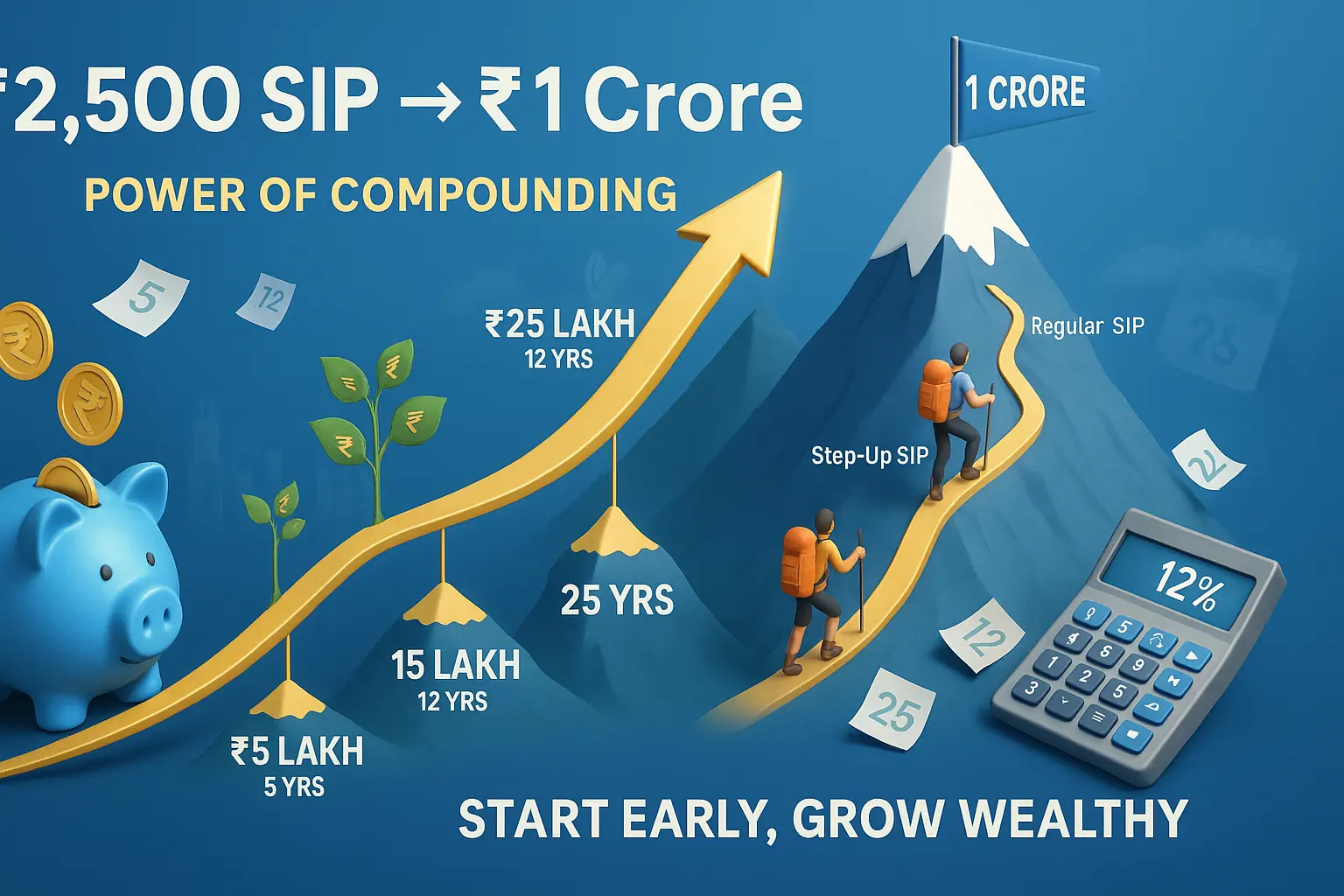Introduction: The Power of Small, Consistent Investments
Did you know that investing just ₹2,500 per month through a Systematic Investment Plan (SIP) can potentially grow into ₹1 crore? This isn’t magic – it’s the power of compounding returns and long-term investing discipline. In this comprehensive guide, we’ll break down:
✅ The exact math behind growing ₹2,500 SIP to ₹1 crore
✅ How different return rates affect your timeline
✅ Real-world case studies of top-performing funds
✅ The game-changing advantage of Step-Up SIPs
✅ Smart strategies to maximize your returns
Section 1: The Mathematics of Growing ₹2,500 SIP to ₹1 Crore
1. Basic Calculation at 12% Annual Returns
- Monthly Investment: ₹2,500
- Expected Annual Return: 12%
- Investment Period Required: 25 years
- Total Invested: ₹7.5 lakh
- Final Value: ₹1.07 crore
Formula used:FV = P × [(1+i)^n - 1] × (1+i)/i
Where:
P = Monthly investment
i = Monthly return rate
n = Number of months
2. How Return Rates Affect Your Timeline
| Annual Return | Years to Reach ₹1 Cr | Total Invested | Final Value |
|---|---|---|---|
| 10% | 30 years | ₹9 lakh | ₹1.01 crore |
| 12% | 25 years | ₹7.5 lakh | ₹1.07 crore |
| 15% | 20 years | ₹6 lakh | ₹1.02 crore |
| 18% | 17 years | ₹5.1 lakh | ₹1.01 crore |
Note: Calculations assume reinvestment of dividends and no withdrawals
Section 2: Real-World Case Studies of Top Performing Funds
Case Study 1: Quant ELSS Tax Saver Fund
- Investment Strategy:
- ₹2,500 monthly SIP
- Additional ₹25,000 lump sum investment
- Historical Performance:
- 17.71% annualized returns over 24 years
- Results:
- Total invested: ₹7.45 lakh
- Maturity value: ₹1.01 crore
Case Study 2: SBI Healthcare Opportunities Fund
- Investment Strategy:
- ₹2,500 monthly SIP for 25 years
- Historical Performance:
- 18.27% annualized returns
- Results:
- Total invested: ₹7.5 lakh
- Maturity value: ₹1.18 crore
Data Sources: Value Research, Morningstar India (July 2025)
Section 3: The Step-Up SIP Advantage (Increase Your SIP by 10% Annually)
Why Step-Up SIP Works Better
By increasing your SIP amount by just 10% each year:
- Start with ₹2,500/month
- Annual increment: 10%
- After 25 years at 12% returns:
- Total invested: ₹29.5 lakh
- Final corpus: ₹1.07 crore
Key Benefit:
You invest more when your earning capacity increases, accelerating wealth creation.
Section 4: Smart Strategies to Maximize Your SIP Returns
1. Fund Selection Strategy
- Equity-Oriented Funds: Aim for 12%+ returns
- Large & Mid-Cap Funds (13-15% historical returns)
- Sectoral/Thematic Funds (Healthcare/Technology)
- Diversification: Spread across 3-4 fund categories
2. Tax Efficiency
- ELSS Funds: Save tax under Section 80C while growing wealth
- Long-Term Capital Gains: 10% tax only above ₹1 lakh profit
3. Risk Management
- Continue SIPs During Market Dips: Buy more units at lower prices
- Rebalance Portfolio Annually: Maintain optimal asset allocation
4. Automation Tools
- Use auto-debit mandates
- Enable dividend reinvestment options
Section 5: Common Investor Questions Answered
Q1. Is 12% return realistic in current market conditions?
Yes, over 25+ years. Nifty 50 has delivered 12.8% CAGR since 1995 (Source: NSE).
Q2. What if I can only invest for 15 years?
At 15% returns:
- ₹2,500 SIP → ₹13.5 lakh
- To reach ₹1 crore, increase SIP to ₹12,000/month
Q3. How to handle market volatility?
- Stay invested for full market cycles
- Consider hybrid funds for moderate risk
Conclusion: Your Roadmap to ₹1 Crore
Action Plan:
- Start Early: Begin your ₹2,500 SIP today
- Choose Growth-Oriented Funds: Aim for 12%+ returns
- Increase SIP Gradually: Implement Step-Up strategy
- Stay Disciplined: Continue for 20-25 years
Remember: The secret isn’t timing the market, but time in the market.
Tools to Use:
Have questions? Ask in comments!
Already investing? Share your portfolio strategy below.
Disclaimer: Mutual fund investments are subject to market risks. Past performance doesn’t guarantee future returns. Consult your financial advisor before investing.


